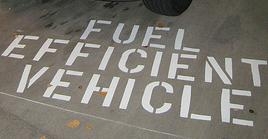
Each generation of car owners has felt the pinch of gasoline prices and knows that it affects the way they travel. As the cost of travel decreases, the number of large vehicle purchases increases. In reverse trends, as the price of travel increases, the consumer purchases less large, inefficient trucks and cars and purchases more efficient vehicles that stretch a dollar of gas.
Without exchanging big for small, you can increase the fuel efficiency of the vehicle you own right now. The best defense against the high price of gas is to buy smart and tune well. You can increase a car's fuel efficiency with a few simple maintenance replacement products and new driving techniques that will make a car run better, farther and for longer on the same gallon of gas, no matter how much that gallon costs.
Fill-up the tank and drive. You should get the most recent average of miles per gallon prior to performing these techniques to increase a car's fuel efficiency. Simply read the odometer prior to filling the tank, and then the reading when the tank is near empty. Now is a good time to insert a fuel additive which will add even more miles per gallon in the tank. Know how many gallons your gas tank holds to discover the current miles per gallon rating. (For example, 237 miles traveled on a full, 12 gallon tank equals 19.75 Miles per Gallon (MPG). Get ready to see some improvement on that MPG rating when finished.
Replace an old air filter with an upgraded high-flow air filter, like the ones sold by the well know filter company K & N (see Resources). A replacement upgrade can also include a new air intake tube and filter which is also an efficiency booster for any combustion engine. For replacement filters, unclasp the stock air box and remove the old filter and replace with a new one. Then secure the air box tightly.
Disconnect the battery from the car's electronic system. Loosen and remove the red cable and secure it away from the battery. Loosen and replace the spark plugs and spark plug wires. Complete the process one at a time to be sure you do not mix up the cables, or make a note of the location and connection of each wire to each spark plug to insure the proper replacement of the spark plus and wires. Before replacing the spark plugs, find the proper gap for the electrode and measure using a simple gap tool. Adjust the gap when needed and replace new plugs for the old ones.
Drain old motor oil through the oil drain plug located near the base of the oil pan. Place in a fluid recycle container and bring to an auto parts shop for recycling. Remove the old oil filter and replace with a new, upgraded oil filter that helps to keep oil temperatures down and fluid flow high. Refill the engine with long life motor oil of good quality. Check for tightness on all fasteners and filters before finishing the maintenance.
Practice good procedures in regards to vehicle weight and air tire pressure. These two problems are responsible for losing up to 35 percent of a car's fuel efficiency. Remove all trash and extra weight from within the vehicle. Some cars contain as much as two hundred pounds of dead weight which diminishes efficiency. Understand and manage the four tire's air pressure each week or daily. Driving on properly inflated tires will allow for all the beneficial actions you took to take effect and work on turning an inefficient car into a fuel-efficient touring car that can drive forever on a single tank of gas. Going from 19.75 MPG to 27 or 30 MPG is possible.